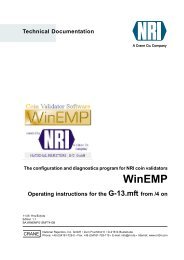3 Other operating modes of the G-18.mft - NRI
3 Other operating modes of the G-18.mft - NRI
3 Other operating modes of the G-18.mft - NRI
You also want an ePaper? Increase the reach of your titles
YUMPU automatically turns print PDFs into web optimized ePapers that Google loves.
G-<strong>18.mft</strong> with vending machine control system DESIGN<br />
Interfaces (on coin validator)<br />
On <strong>the</strong> rear <strong>of</strong> <strong>the</strong> coin validator <strong>the</strong>re is a 6-pole 8 and a 14-pole 6 interface<br />
to <strong>the</strong> additional control PCB (to <strong>the</strong> vending machine). At <strong>the</strong> bottom <strong>of</strong> <strong>the</strong><br />
device <strong>the</strong>re is a connecting plug 10 for <strong>the</strong> PC programming station or <strong>the</strong><br />
Palm handheld. Peripheral devices, such as a display or card reader, can<br />
be connected to <strong>the</strong> 10-pole MDB interface 5. (See Fig. 1a)<br />
Interfaces 8/6 – additional control PCB (6-/14-pole)<br />
These two interfaces are used to connect <strong>the</strong> coin validator to <strong>the</strong> additional<br />
control PCB to which <strong>the</strong> vending machine components such as <strong>the</strong> battery,<br />
escrow, selection buttons, pilot lights, product ejectors, and return<br />
mechanism are connected (see section "The additional control PCB" in this<br />
chapter).<br />
Interface 5 – MDB periphery (10-pole)<br />
If <strong>the</strong> G-<strong>18.mft</strong> is operated as a 1-5-chute vending machine control system,<br />
use an MDB cable set to connect all slave devices, such as an MDB card<br />
reader and MDB display to this interface (see section "Accessories" in<br />
Chap. 10 "Technical data").<br />
National Rejectors, Inc. GmbH, Buxtehude<br />
For fur<strong>the</strong>r information on <strong>the</strong> MDB interface, please refer to "NAMA<br />
document MDB/ICP, 2.0" (www.vending.org).<br />
For details regarding pin assignment, see section "Pin assignment<br />
and connection diagrams" in Chap. 10 "Technical data".<br />
Pin 7 <strong>of</strong> this interface has been assigned to a wake-up line. The coin validator<br />
itself is woken up from an energy-saving standby mode by <strong>the</strong> insertion <strong>of</strong><br />
a coin and <strong>the</strong>n wakes up all connected slave devices via <strong>the</strong> wake-up line.<br />
The coin validator is now in its active state and keeps <strong>the</strong> wake-up line on<br />
"low" = active (all devices ready for operation) until <strong>the</strong> inserted coin has<br />
been processed.<br />
Interface 10 – configuration (WinEMP/PalmEMP)<br />
To configure <strong>the</strong> coin validator <strong>the</strong> device is connected to a PC or a mobile<br />
Palm handheld. For that purpose, <strong>the</strong> G-<strong>18.mft</strong> is equipped at <strong>the</strong> bottom<br />
with a PCB direct plug (see Fig. 1a), which is used to connect <strong>the</strong> coin<br />
validator to <strong>the</strong> PC programming station or to a Palm handheld. The device<br />
can <strong>the</strong>n be set up using <strong>the</strong> configuration and diagnostics s<strong>of</strong>tware<br />
"WinEMP" or "PalmEMP" (see Chap. 6 "Starting up" and Chap. 9 "Which<br />
functions can be set using WinEMP/PalmEMP?").<br />
For details regarding pin assignment, see section "Pin assignment<br />
and connection diagrams" in Chap. 10 "Technical data".<br />
19
















